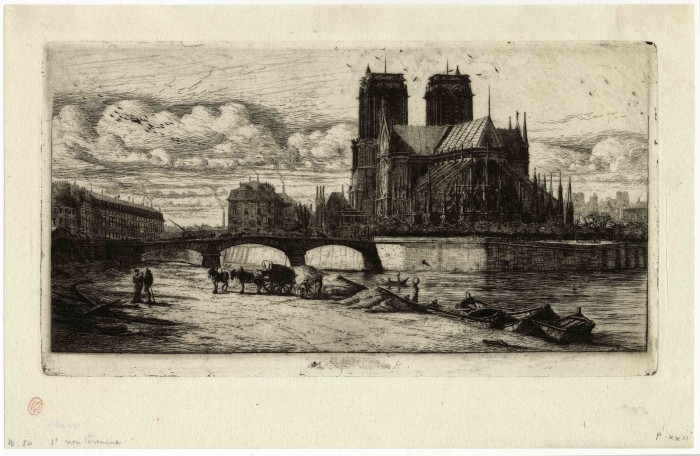L’Abside de Notre-Dame – The Apse of Notre-Dame, Paris, 3rd State, 1854
Charles Meryon
1821 – Paris – 1868
L’Abside de Notre-Dame – The Apse of Notre-Dame, Paris 1854
etching with engraving and drypoint on thin laid paper; 163 x 300 mm (6 7/16 x 11 3/4 inches)
annotated in pencil at lower left “B. 50 [!] 1e non termine”
Burty 52; Delteil 38 third state (of eight); Schneiderman 45 third state (of nine)
watermark
CONTRIBUTIONS DIRECTES
provenance
Émile Galichon (1829-1875), Paris (Lugt 856; cf. also Lugt 1058f, which mentions his posthumous 1875 sale of Meryon.)
his sale, Paris (expert Clément), May 10-14, 1875
Phillipe Burty (1830-1890), Paris (Lugt 413; cf. the entry Lugt 2071 which mentions the sales of Burty’s collection)
his sale, Sotheby’s, London, April 27ff., 1876
possibly Francis Seymour Haden, London and Arlesford (cf. Lugt 1227 et al.; not stamped but annotated in pencil verso “Haden”)
Lugt refers to the sale (April 27 ff., Paris) of Burty’s first state impression of L’Abside; this is incorrect since the first state is unique (it is in the National Gallery, with an extensive provenance not including Burty); quite certainly Lugt is referring to our impression (which is also incorrectly noted as a first state in pencil on the recto, lower left). (Lugt: Dans cette vente figurait son œuvre exceptionnel de Meryon, 217 pièces en états variés, dont nous citons : L’Abside de Notre-Dame, 1r ét. £ 17….)
Phillipe Burty was an eminent art critic and collector; he was among the first to recognize the genius of Meryon, and wrote the first catalogue raisonne of his work.
Burty wrote of L’Abside: “The view of Notre-Dame…is a magisterial sight. The church of Notre Dame seems to have exerted a great attraction on the dreamy spirit of the artist. It has dictated to a poet [Victor Hugo] one of the beautiful books of our generation; it has inspired in Meryon his most beautiful plate.”
